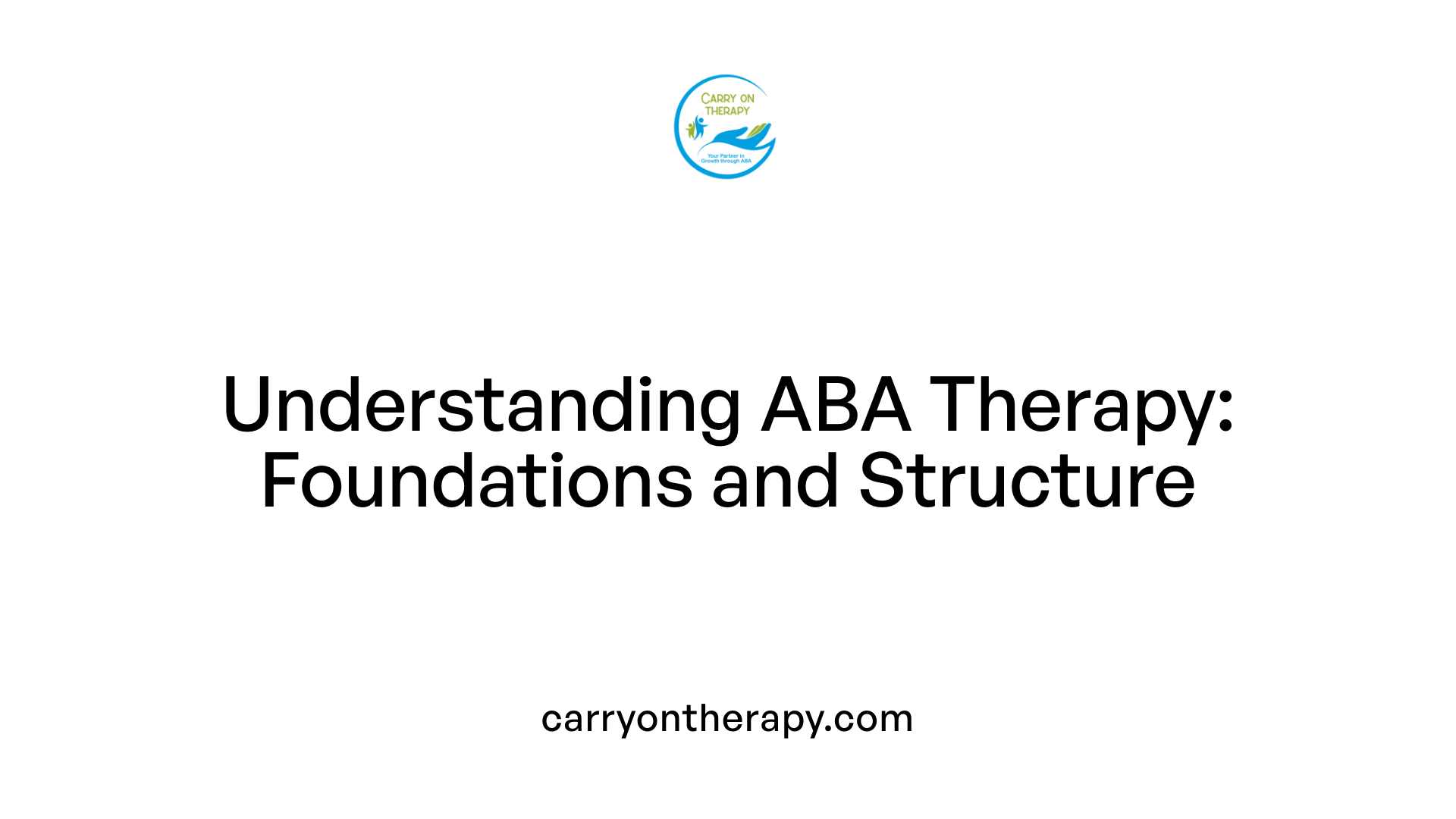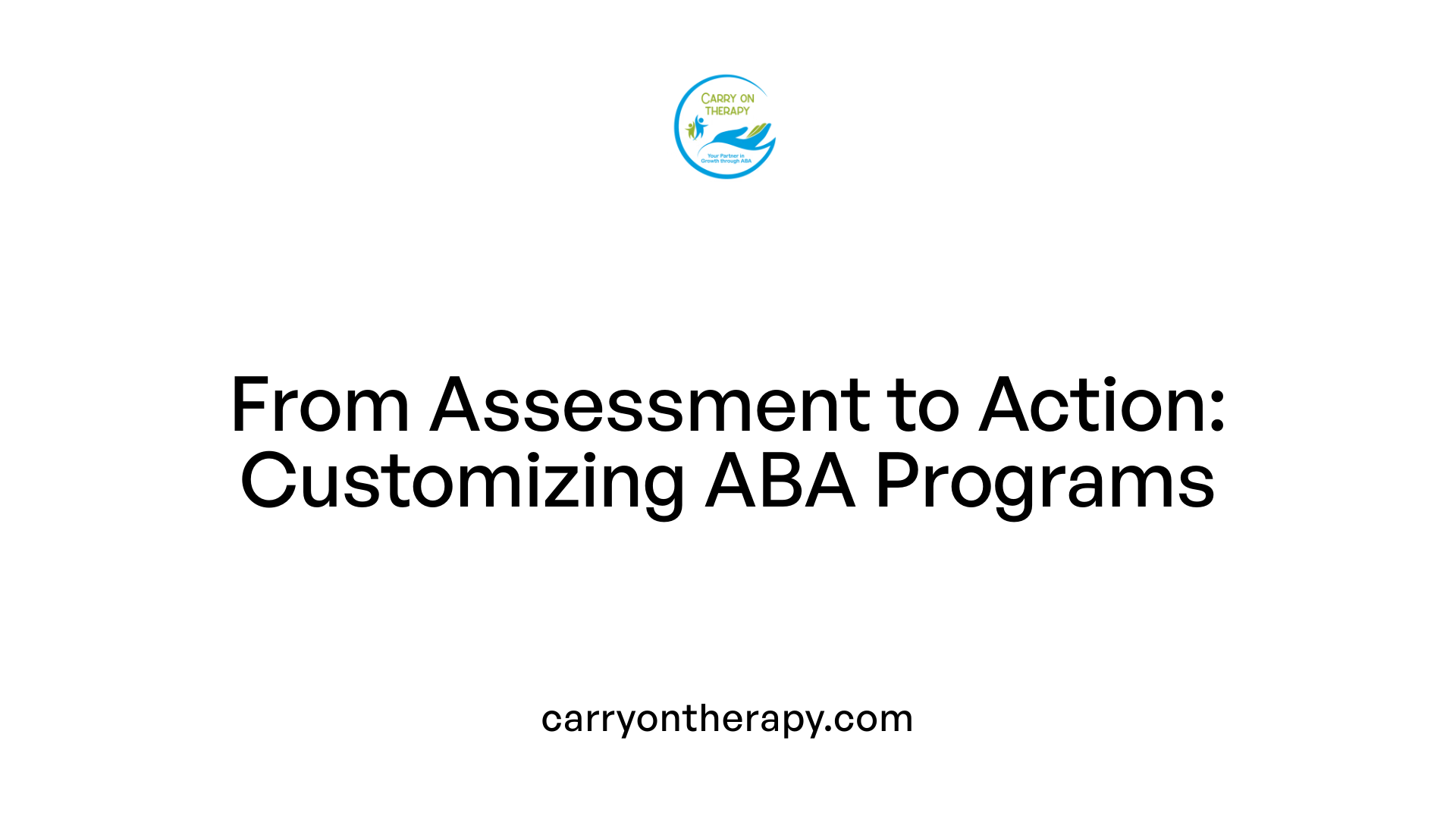The Importance of Therapist-Parent Communication for Progress
Enhancing Therapy Outcomes Through Collaborative Parent-Therapist Partnerships

Understanding the Role of Communication in ABA Therapy
Applied Behavior Analysis (ABA) therapy has become a cornerstone in autism treatment, providing structured, evidence-based approaches to develop vital skills. However, the success of ABA therapy hinges not only on expert intervention but equally on the active participation and communication between therapists and parents. This article explores how effective collaboration between families and professionals amplifies progress, tailors interventions, and ensures meaningful, lasting benefits for children with autism.
What is ABA Therapy and How Does It Operate?

What is Applied Behavior Analysis (ABA) Therapy?
Applied Behavior Analysis (ABA) therapy is a structured, evidence-based treatment used primarily for children diagnosed with autism. It works by applying behavior analysis principles to encourage positive behaviors and develop skills in communication, social interaction, and daily living.
How Does ABA Therapy Use Positive Reinforcement?
At the core of ABA therapy is positive reinforcement. This means rewarding desirable behaviors to motivate the child to repeat them. Rewards can include praise, toys, activities, or treats, each tailored to what motivates the individual child.
Structure and Personalization of ABA Therapy
ABA therapy is highly personalized. Certified therapists, often Board Certified Behavior Analysts (BCBAs), assess the child's specific needs and design individualized plans. These plans include measurable goals that focus on improving social skills, communication, and independence. Sessions typically happen in real-life settings like homes or schools to enhance practical learning.
Key Techniques in ABA
Therapists use various techniques such as discrete trial training, which breaks skills into small steps, and naturalistic approaches that embed learning in everyday interactions. Ongoing data collection helps monitor progress, allowing therapists to adjust strategies to fit the child's development.
Why is Generalization Important?
Teaching skills is just one part; ABA therapy places strong emphasis on the generalization of skills across settings. This means children learn to apply new behaviors not only during therapy but also at home, school, or community, ensuring the benefits are lasting and relevant.
This carefully structured approach, combining personalized plans, positive reinforcement, and cross-setting learning, enables children with autism to build vital skills and improve behaviors effectively.
Professionals Behind ABA Therapy: Who Delivers It?

Who Typically Provides ABA Therapy for Individuals with Autism?
ABA therapy is delivered by a team of skilled professionals, with Board Certified Behavior Analysts (BCBAs) playing a central role. BCBAs are highly trained experts responsible for conducting initial assessments, developing individualized treatment plans, and adjusting therapy based on the child's progress.
Role of Therapists and Behavior Technicians
Direct therapy sessions are typically led by Behavior Technicians or ABA therapists. These professionals implement the strategies designed by BCBAs, working closely with the child to teach communication, social skills, and daily living activities using behavior analysis techniques. They often operate under the supervision of BCBAs to ensure fidelity and effectiveness.
Settings Where ABA Is Provided
ABA therapy is delivered in various environments to help generalize skills effectively. Common settings include homes, schools, clinics, and community spaces. This real-life application ensures that children can use learned skills across different contexts, enhancing independence and social functioning.
Caregiver Involvement in Therapy Delivery
Caregivers, especially parents, are integral to the therapy process. They receive training to reinforce skills and behaviors outside formal sessions, ensuring consistency and supporting generalization. Their active involvement increases therapy success by maintaining momentum between sessions.
Team-Based Approach
ABA therapy is a collaborative effort among BCBAs, therapists, and families. Regular communication and data sharing allow the team to tailor interventions, address challenges promptly, and celebrate progress. This multifaceted approach fosters a supportive environment that promotes lasting positive outcomes for children with autism.
Goal Setting in ABA Therapy: Tailoring for Each Child

What are the Typical Goals of ABA Therapy in Autism Treatment?
ABA therapy focuses on developing personalized goals that help children with autism improve essential life skills. These goals commonly target communication, social interactions, and daily living skills, aiming to foster greater independence and adaptive functioning.
Individualized Goal Development
Goals in ABA therapy are tailored based on a thorough initial assessment conducted by certified behavior analysts. They observe the child's behaviors in day-to-day settings to understand strengths, challenges, and specific learning needs. This process ensures that goals address each child's unique developmental profile and family circumstances.
Focusing on Communication, Social, and Daily Living Skills
Therapy plans emphasize skills that aid effective social engagement and daily functioning. Children learn how to express needs, initiate and maintain social interactions, and perform everyday tasks that enhance their autonomy.
Use of SMART Goals
Goals are often framed using the SMART criteria—Specific, Measurable, Achievable, Relevant, and Time-bound. This structure allows for clear tracking of progress, helping therapists and families measure improvement precisely and adapt interventions when necessary.
Addressing Challenging Behaviors
ABA therapy also targets challenging or problematic behaviors. Through positive reinforcement strategies, the therapy aims to reduce these behaviors by encouraging desirable alternatives, improving emotional regulation and overall behavior.
Long-Term Independence and Adaptive Functioning
Ultimately, goals are designed not only to support immediate skill acquisition but also to promote long-term independence. By generalizing learned skills across settings like home, school, and community, children gain adaptive functions critical for everyday success and quality of life.
Customizing ABA Therapy Programs: From Assessment to Implementation

Initial Behavior Assessments
ABA therapy begins with a thorough assessment conducted by a certified behavior analyst. This assessment involves observing the child's behavior in everyday settings such as home and school to identify both desirable and challenging behaviors. Understanding the child's unique strengths, developmental delays, and learning style helps form a solid foundation for the therapy plan.
Individualized Program Design
Following the assessment, therapists set clear and tailored goals based on the child's developmental needs. These goals often focus on improving communication, social interactions, and independence. The therapy program is customized by selecting specific intervention strategies, including positive reinforcement techniques like praise or preferred activities, to motivate the child effectively.
Incorporation of Child’s Strengths and Preferences
A child’s interests and preferences are integrated into the program to enhance engagement and learning. For example, favorite toys or activities may be used as rewards to encourage positive behaviors. This personalized approach not only boosts motivation but also respects the child’s individuality.
Collaboration with Families for Consistency
Consistent reinforcement at home is critical for generalizing skills learned during therapy. Parental involvement is fostered through training programs that equip families with methods such as prompting and task analysis. Open communication and collaboration between therapists and parents help maintain consistency, which greatly improves therapeutic outcomes.
Ongoing Monitoring and Adjustments
Therapy progress is continuously tracked through data collection and regular evaluations by behavior analysts. This monitoring allows for timely adjustments to goals and strategies, ensuring the program stays aligned with the child's evolving needs and maximizes developmental gains.
| Aspect | Description | Purpose |
|---|---|---|
| Assessment | Observations in natural settings by a certified analyst | Identify behavior patterns and developmental needs |
| Goal Setting | Development of individualized goals based on assessment | Focus therapy on relevant skills |
| Personalized Reinforcers | Use of preferred rewards aligned with child's interests | Enhance motivation and engagement |
| Parent Collaboration | Training and regular communication between therapists and families | Promote consistency and skill generalization |
| Monitoring & Evaluation | Continuous data collection and progress review | Adapt therapy to changes and sustain progress |
The Critical Role of Parental Involvement in ABA Therapy

What Are the Benefits of Parent Training Programs?
Parent training programs are integral to ABA therapy because they empower families with effective strategies such as prompting, task analysis, and positive reinforcement. Through these programs, parents learn how to manage challenging behaviors and reinforce skills consistently at home. Research shows that such training significantly improves a child's progress and boosts parental confidence, making therapy more successful.
How Do Parents Use Reinforcement Techniques?
Parents can reinforce positive behaviors by using praise, rewards like stickers, treats, or extra playtime. This approach motivates children and helps them understand that communication and social skills are valuable across various situations, not just during therapy sessions. Employing reinforcement at home strengthens the child's learning and encourages skill retention.
Why Is Enhancing Therapy Consistency Important?
Consistency between therapy sessions and the home environment enhances the effectiveness of ABA therapy. When parents apply the same strategies regularly, children acquire new behaviors faster and reduce challenging behaviors. This continuous reinforcement creates a supportive atmosphere that fosters steady progress.
How Do Parents Support Generalization of Skills Across Settings?
By applying learned behaviors at home, school, and community environments, parents help children generalize skills beyond the therapy room. Techniques like incorporating visual aids, maintaining routines, and involving the child in family activities ensure that the child uses communication and social skills in daily life, supporting long-term success.
What Role Do Parents Play in Advocacy and Navigating Resources?
Parents are vital advocates for their children's educational and developmental needs. Being actively involved allows them to communicate with professionals, participate in meetings, and navigate available resources effectively. This advocacy role ensures that therapy remains tailored and that the child's rights are met in various settings.
| Aspect | Description | Impact on Child and Family |
|---|---|---|
| Parent Training Programs | Teach strategies for behavior management and skill reinforcement | Enhances child progress and parental confidence |
| Reinforcement Techniques | Use of praise and rewards to encourage behaviors | Motivates child and promotes skill retention |
| Therapy Consistency | Applying strategies regularly at home and in therapy | Speeds up learning and reduces challenging behaviors |
| Skill Generalization | Practicing skills across different settings | Supports long-term, real-life application of skills |
| Advocacy and Resource Navigation | Parents communicate and navigate educational and community resources | Ensures tailored therapy and protection of child's rights |
Communication: The Bridge Between Therapist and Parent
Importance of regular updates and feedback
Consistent communication ensures that parents stay informed about their child's progress and any challenges encountered during ABA therapy sessions. Regular updates from therapists provide a clear picture of which skills have improved and areas needing more focus.
Collaborative goal adjustments
Open dialogue between therapists and parents allows for collaborative adjustments to therapy goals. Since ABA therapy is personalized, parents' observations at home help therapists tailor plans according to the child’s evolving needs.
Addressing challenges through open dialogue
When parents openly share concerns or behavioral issues they observe, therapists can offer strategies or modify interventions to better support the child. This proactive exchange helps address barriers quickly.
Building trust and mutual understanding
Transparent communication fosters trust, enabling parents to feel confident in the therapy process. Mutually respectful conversations strengthen this partnership for the child's benefit.
Impact on therapy effectiveness
Effective communication improves consistency between home and therapy sessions, optimizing reinforcement of positive behaviors. This, in turn, accelerates learning, supports skill generalization, and contributes to better overall outcomes in ABA therapy.
Supporting Skill Generalization Through Parent-Therapist Collaboration
Applying Learned Behaviors at Home and Community
Parents play an essential role in helping children with autism generalize the skills learned during ABA therapy to everyday settings. By applying strategies and behaviors taught during therapy sessions at home and in the community, children can practice and reinforce communication, social, and daily living skills in varied environments. This consistent practice ensures that skills are not limited to the therapy setting but become part of the child's natural behaviors.
Using Positive Reinforcement Consistently
Consistent use of positive reinforcement, such as praise, rewards, or preferred activities, is a powerful tool parents use to encourage desirable behaviors outside of therapy. When parents mirror the reinforcement methods used by therapists, children more readily understand that positive behaviors are valued across settings. This consistency strengthens motivation and supports lasting behavior change.
Incorporating Therapy Strategies into Daily Routines
Effective skill generalization requires seamlessly integrating ABA strategies into daily life without overwhelming the family. Parents, guided by therapists, incorporate techniques like prompting and task analysis into routines such as mealtime, play, or getting dressed. Visual aids such as picture cards and charts help children follow tasks and routines, making transitions smoother and reinforcing skills in real time.
Examples of Generalization Success Stories
Many families observe remarkable progress when parents actively support skill transfer. For instance, a child who learned to request toys during therapy might begin asking for them at home and in social settings. Another child might use learned social greetings across multiple environments. These successes highlight the positive impact of close parent-therapist collaboration.
Tools to Aid Skill Transfer Such as Visual Aids
Visual supports, including charts, stickers, and picture cards, serve as practical reminders and motivators to help children understand and perform tasks independently. Therapists often train parents in using these tools effectively. Together, parents and therapists create an inclusive environment that encourages consistent skill use and generalization.
Through ongoing collaboration, communication, and training, parents and therapists create a strong support system that promotes the generalization of skills vital for a child's growth and independence.
Training Parents: Empowering Families for Effective Support
Parent education workshops and resources
ABA therapy programs often include comprehensive parent education through workshops, training sessions, and online resources. These empower families with knowledge about autism and the principles of behavior analysis, making them active participants in their child's therapy journey.
Techniques taught including prompting and task analysis
Parents learn practical ABA techniques such as prompting, where they guide their child gently toward correct responses, and task analysis, which breaks down complex skills into manageable steps. These strategies help parents effectively support skill acquisition at home.
Managing challenging behaviors at home
Training also equips parents with tools to understand and manage challenging behaviors calmly and consistently. By applying positive reinforcement and behavior management strategies taught by therapists, parents can foster a supportive environment that encourages positive change.
Building parental confidence and persistence
Consistent training and involvement boost parental confidence, enabling them to handle therapy demands and celebrate small milestones. This persistence is vital for sustaining progress and motivating children through their learning process.
Balancing therapy demands with family life
Parent training emphasizes integrating ABA techniques smoothly into daily routines without overwhelming families. By balancing therapy activities with play, rest, and family time, parents create a nurturing setting that supports sustainable growth and well-being for the child and family alike.
Evidence Supporting Parental Involvement in Therapy Outcomes
Research Findings on Parent Training Effectiveness
Research consistently highlights the importance of parent training within ABA therapy for autism. Studies by Koegel et al. (2019), Reichow et al. (2018), Hume et al. (2020), and Smith et al. (2021) demonstrate that training parents to use ABA techniques significantly enhances a child's learning and behavior. Parents who receive training can better implement strategies such as prompting, task analysis, and reinforcement, translating therapy gains into everyday environments.
Improved Child Outcomes Due to Family Participation
Family participation is linked with faster and more consistent progress. When parents actively reinforce desirable behaviors using positive reinforcement like praise or rewards, children generalize skills learned during therapy to home, school, and community settings. This consistency reduces challenging behaviors and supports social communication and independence development.
Enhanced Parental Confidence and Advocacy
Parental involvement fosters confidence in managing behaviors and advocating for their child's needs. Educated families navigate educational resources and communicate more effectively with professionals. Training programs empower parents to set realistic goals, celebrate milestones, and maintain motivation throughout their child’s therapy journey.
Role in Long-Term Therapy Success
The durability of ABA therapy benefits hinges on consistent support across contexts. Parents act as integral partners by reinforcing skills beyond sessions, ensuring generalization and preventing skill regression. Long-term success is more achievable when parents maintain active involvement and collaborate closely with therapists.
Synergy Between Professional Interventions and Home Support
A strong alliance between certified ABA therapists and parents creates a cooperative environment where data-driven therapy plans are adapted based on ongoing observations both in sessions and at home. Regular communication promotes shared decision-making and responsive goal adjustments, maximizing therapy effectiveness.
What is the evidence supporting the effectiveness of ABA therapy for autism?
ABA therapy's effectiveness is supported by over 40 years of rigorous research including randomized controlled trials and meta-analyses. These studies reveal significant improvements in IQ, language, social skills, and adaptive behavior for children with ASD. The integration of parent training with individualized therapy plans enhances these outcomes and facilitates better school inclusion and reduced severity of symptoms. ABA’s comprehensive, evidence-based approach establishes it as a highly effective intervention for autism spectrum disorder.
Fostering a Supportive Home Environment for Therapy Success
Establishing routines incorporating therapy and play
Creating a balanced daily routine that includes time for ABA therapy activities, play, and rest is essential. Consistent scheduling helps children understand expectations and reduces anxiety, supporting smoother skill acquisition.
Use of visual aids like charts and picture cards
Visual aids such as charts and picture cards serve as effective tools to simplify communication and clarify tasks. They enhance understanding and support children in navigating daily routines, reinforcing the learning from therapy sessions.
Celebrating small milestones to motivate children
Acknowledging and celebrating small achievements encourages motivation and boosts self-esteem. Parents can use praise, stickers, or extra playtime as positive reinforcement strategies that help maintain the child’s engagement.
Providing emotional support and encouragement
Emotional support from parents is fundamental to the child's willingness and enthusiasm for therapy. Staying patient, calm, and encouraging helps children overcome challenges and fosters a positive learning atmosphere.
Adapting the home setting to enhance learning
Modifying the home environment to be inclusive and supportive of therapy goals promotes skill generalization. Involving the child in family routines and adjusting physical spaces to reduce distractions and highlight learning cues can significantly benefit progress.
Together, these supportive home strategies form a crucial foundation that complements ABA therapy sessions, helping translate progress into meaningful, long-lasting improvements in communication, behavior, and independence.
Sustaining Progress: Continuous Collaboration and Advocacy
Ongoing Parent-Therapist Meetings
Regular meetings between parents and ABA therapists are essential for maintaining open dialogue about the child's progress and challenges. These sessions provide a platform for parents to share observations from home and receive professional feedback, ensuring that therapy remains closely aligned with the child's evolving needs.
Adjusting Therapy Plans Based on Feedback
Feedback gathered from parents during these meetings allows behavior analysts to refine and adapt therapy plans. This ongoing evaluation ensures that goals remain relevant and that new strategies can be implemented promptly to address any emerging concerns or developmental changes.
Parents as Advocates in Education and Community
Parents play a critical role in advocating for their child’s rights and needs within educational settings and the broader community. Informed and engaged parents can better navigate resources, secure appropriate services, and foster inclusive environments that support their child's growth and learning.
Encouraging Parental Questions and Proactive Engagement
Effective therapy collaboration thrives when parents feel empowered to ask questions and actively participate in decision-making. Proactive involvement enhances consistency in applying ABA strategies across settings and encourages a supportive atmosphere that benefits the child’s development.
Long-term Commitment and Patience in Therapy Journey
ABA therapy typically spans one to three years, demanding sustained parental involvement and patience. Recognizing that progress may be gradual helps families stay motivated and resilient, ultimately contributing to meaningful and lasting skill acquisition for the child.
Therapist-Parent Communication: A Cornerstone for ABA Therapy Success
ABA therapy offers transformative possibilities for children with autism, but its full potential is realized when therapists and parents work hand in hand. Effective communication creates a dynamic partnership that ensures customized interventions remain relevant, promotes consistency across environments, and empowers families to support their children's growth. As research confirms, parent involvement not only improves child outcomes but also strengthens families' ability to navigate challenges with confidence. Ultimately, fostering open dialogue and collaboration between therapists and parents is essential for sustained progress, meaningful skill generalization, and enhanced quality of life for children with autism.
References
- What Parents Need to Know About ABA Therapy for Autism
- The Role of Parent Involvement in ABA Therapy Success
- Parental Role in ABA Therapy
- Importance of Parents Involvement in ABA Therapy for Autism
- The Role of Family in ABA Therapy: Tips for Parents
- How to Implement Custom ABA Therapy for Your Loved One
- Applied Behavior Analysis (ABA)
- Why Customized ABA Therapy Plans Matter







